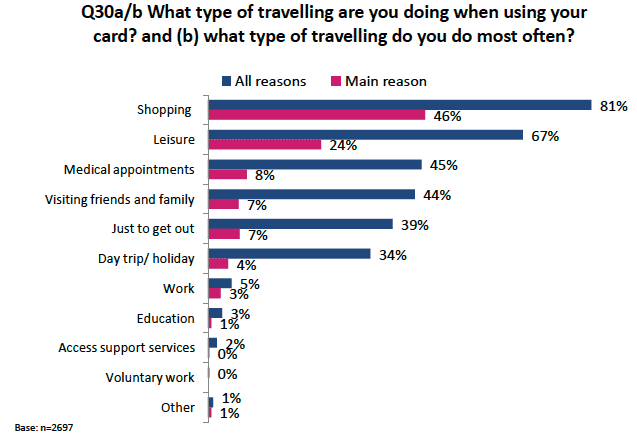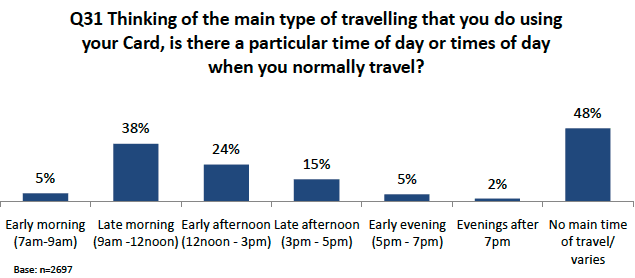5. How and why the card is used
5. How and why the card is used
Introduction
5.1 Respondents were asked about the type of travelling that they did when using the card, in order to develop a picture of how and why the card was used.
5.2 Respondents were asked about the type of travelling that they do when using the card. More than 8 in 10 respondents said they use the card for shopping, 67% use it for leisure, 45% use it for medical appointments and 44% use it for visiting friends and family. In terms of the main reason for using the card, again shopping was the most popular response (46%), followed by leisure (24%) and medical appointments (8%).
Figure 5.1: Reason for travelling done when using the card

5.3 There was, unsurprisingly, a significantly lower proportion of those aged over 65 using their card for work purposes, with just under one in ten respondents aged under 60 (8%) stating that they used their card most often for work purposes.
5.4 Analysis by card type indicated that those with Disabled or Visual cards were more likely use their card for medical appointments (20% compared to 6% of 60+ card holder).
5.5 Card holders with the 60+ card were more likely to use the card most often for social and leisure purposes with 84% stating that they use their card most often for shopping, leisure, visiting friends and family or day trips/ holidays. This is compared to 60% of Disabled or Visual card holders.
5.6 Focus group participants used their NEC for a number of different types of journeys. Typical reasons for travel included shopping, visiting friends and family, as well as attending hospital or medical appointments. Some of the younger participants were attending college, or had volunteering jobs and regularly travelled by bus to access these.
"I use mine quite a lot. Three days a week I volunteer and on a Friday I do my shopping."
(Male, young disabled group)
Typical time of day of travelling
5.7 When asked about the typical time that they travel when using their card, just under half (48%) said that there was no main time of travel and that it varies. On the other hand, 38% said they typically travel late morning between 9am and 12 noon. In line with the type of travelling that they are doing, respondents aged under 60 were more likely to travel early morning (12%) than older age groups.
Figure 5.2: Typical time of travel using card

5.8 The focus group findings revealed that there was no real consistency in the times of day when the NEC was used. Some people used it in the morning and others for "the occasional evening". However some participants commented that they did not like to use the bus at night, and would prefer a taxi in these circumstances.
"At night I would take the bus and go to the pictures."
(Male, learning disabilities group)
"I take a taxi when I go out on a Saturday night, I'm not confident at night on the buses."
(Female, blind and visually impaired group)
5.9 When asked about the sorts of distances normally travelled varied when using the card, 19% said they typically travel less than 5 miles, 21% said between 5 and 10 miles, 18% said 10 to 25 miles and 19% said more than 25 miles.
5.10 Analysis by area revealed significant differences in the distance travelled with respondents who lived in HITRANS (34%), ZetTrans (33%) and SwesTrans (31%) areas were most likely to use their card for longer distances of 50 miles or over. This is compared to the SPT area where 49% used their card to travel less than 10 miles and just 5% to travel distances of 50 miles or over.
5.11 Some participants at the focus groups had used their cards to travel outwith their own local authority area. Journeys to cities such as Glasgow or Edinburgh were commonly noted by participants in Aberdeen, Stirling and Inverclyde.
5.12 Some disabled participants mentioned that they would like to travel further away using their NEC, but they were concerned that there might not be a bus with suitable disabled access available to bring them back. These participants were sometimes required to book in advance, to ensure that the right equipment was available to allow them access to the bus.
"I wouldn't take the chance further away - I'm not sure I would get back."
(Female, physical disabilities group)
"I don't use the bus as much as I would like to because I need to call ahead and book a space on a bus that can accommodate me, and I'm not a good planner."
(Male, young disabled group)
5.13 Participants in the young, Asian deaf group indicated that they sometimes used their card to travel from Glasgow to Edinburgh. Their perception was that members of the deaf community were not aware that the card could be used to travel further away.
"Deaf people might not realise that it is a national card and that they can travel further away."
(Female, young Asian deaf group)
"It's a communication issue. There needs to be confidence to use the card. People use it locally because they can't pronounce where to go or spell it."
(Female, young Asian deaf group)
5.14 With regards to the frequency of travel, 26% of respondents said they typically travel by bus less than once per week, 10% said they travelled once per week, 24% said they travelled between 2 and 3 times per week, 24% travelled between 4 and 7 times per week and 16% said they travelled by bus more than 7 times per week.
5.15 Analysis by area indicates that those who live in the HITRANS area significantly less likely to use their card on a weekly basis than other areas. Respondents in the SESTRANS and SPT areas were most likely to travel by bus more regularly than other areas with 20% and 17% respectively stating they travel by bus more than 7 times per week.
5.16 Disabled and Visual card holders were more likely to travel by bus more frequently with 50% travelling by bus using their card 4 or more times per week compared to 38% of 60+ card holders.
5.17 The majority of focus group participants stated that they used their card regularly. This could be a few times a week, or for some their card was used every day.
5.18 Drivers in five of the eight focus group discussions stated their preference to travel by car, unless the destination was more easily accessed by bus, for example, travelling into the city centre. They preferred to use their card if going into a city centre, to avoid traffic and parking fees.
"I don't use the car in town; it's much easier and faster on the bus."
(Female, older person's group)
5.19 The main reason for travelling using their card was identified as being for shopping or leisure purposes. This was the case for all cardholders, although the research did reveal that those who held Disabled or Visual Impairment cards were more likely to use their cards to travel for medical appointments or work purposes. This is potentially likely to be the case as the age profile of these cardholders was significantly younger than for the 60+ population.
5.20 Analysis of how the card was used showed significant differences in relation to where the respondent lived. For example, those living in more rural areas, in particular in the HITRANS area, were significantly more likely to use their card to travel longer distances and likely to use their card and less likely to use their card as frequently as in other areas. This was in comparison to those living in the SPT area who were most likely to travel shorter distances and use their card more frequently.